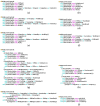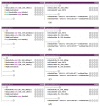Ontology-Based High-Level Context Inference for Human Behavior Identification
- PMID: 27690050
- PMCID: PMC5087405
- DOI: 10.3390/s16101617
Ontology-Based High-Level Context Inference for Human Behavior Identification
Abstract
Recent years have witnessed a huge progress in the automatic identification of individual primitives of human behavior, such as activities or locations. However, the complex nature of human behavior demands more abstract contextual information for its analysis. This work presents an ontology-based method that combines low-level primitives of behavior, namely activity, locations and emotions, unprecedented to date, to intelligently derive more meaningful high-level context information. The paper contributes with a new open ontology describing both low-level and high-level context information, as well as their relationships. Furthermore, a framework building on the developed ontology and reasoning models is presented and evaluated. The proposed method proves to be robust while identifying high-level contexts even in the event of erroneously-detected low-level contexts. Despite reasonable inference times being obtained for a relevant set of users and instances, additional work is required to scale to long-term scenarios with a large number of users.
Keywords: activities; context inference; context recognition; emotions; human behavior identification; locations; ontological reasoning; ontologies.
Conflict of interest statement
The authors declare no conflict of interest.
Figures










References
-
- Ke S.R., Thuc H.L.U., Lee Y.J., Hwang J.N., Yoo J.H., Choi K.H. A review on video-based human activity recognition. Computers. 2013;2:88–131. doi: 10.3390/computers2020088. - DOI
-
- Lara O.D., Labrador M.A. A survey on human activity recognition using wearable sensors. IEEE Commun. Surv. Tutor. 2013;15:1192–1209. doi: 10.1109/SURV.2012.110112.00192. - DOI
-
- Fallah N., Apostolopoulos I., Bekris K., Folmer E. Indoor human navigation systems: A survey. Interact. Comput. 2013;25:21–33.
-
- Fasel B., Luettin J. Automatic facial expression analysis: A survey. Pattern Recognit. 2003;36:259–275. doi: 10.1016/S0031-3203(02)00052-3. - DOI
-
- Koolagudi S.G., Rao K.S. Emotion recognition from speech: A review. Int. J. Speech Technol. 2012;15:99–117. doi: 10.1007/s10772-011-9125-1. - DOI
LinkOut - more resources
Full Text Sources
Other Literature Sources

